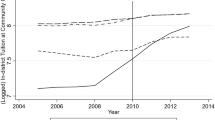Abstract
We study how tuition discounting affects the financial decisions of universities, their student recruitment, and reputation. Using a large panel data of U.S. private and public four-year institutions, we find that tuition discounting helps institutions enhance their short-term operating surplus, increase admission yield, and reduce drop-out rate. However, it does not appear to improve the graduation rate or the quality of the incoming students. Institutions relying more on tuition discounting have more financial leverage, less equity, and experience lower liquidity and asset turnover—indicating greater financial risk. These results are stronger for private universities. Finally, out-of-sample tests show that tuition discounting may not help enhance the reputation of private universities.
Similar content being viewed by others
References
Bajeux-Besnainou I, Ogunc K (2006) Spending rules for endowment funds: a dynamic model with subsistence levels. Rev Quant Finance Account 27(1):93–107
Barber B, Wang G (2013) Do (some) university endowments earn alpha? Financ Anal J 69(5):26–44
Baum S, Lapovsky L, Ma J (2010) Tuition discounting: institutional aid patterns at public and private colleges and universities, 2000–01 to 2008–09. College Board Advocacy and Policy Center, Washington, DC
Behaunek L, Gansemer-Topf A (2017) Tuition discounting at small, private baccalaureate institutions: reaching a point of no return? Working paper
Blume M (2010) Endowment spending in volatile markets: what should fiduciaries do? Rev Quant Finance Account 35(2):163–178
Browning J (2013) Determining a relationship between higher education financial position and tuition discount rates. Res High Educ J 20:1–34
Bruinicks R, Keeney B, Thorp J (2010) Transforming America’s universities to compete in the “New Normal”. Innov High Educ 35(2):113–125
Cabrera A, La Nasa S (2000) Understanding the college-choice process. New Dir Inst Res 107:5–22
Davis J (2003) Unintended consequences of tuition discounting. Lumina Found Educ New Agenda Ser 5(1):1–40
Dynarski S (2000) Hope for whom? Financial aid for the middle class and its impact on college attendance. NBER working paper 7756
Guo L, Jalal A, Khaksari S (2015) Bank executive compensation structure, risk taking and the financial crisis. Rev Quant Finance Account 45:609–639
Hillman N (2010) Tuition discounting for revenue management. Working paper, University of Utah
Hung C, Banerjee A, Meng Q (2017) Corporate financing and anticipated credit rating changes. Rev Quant Finance Account 48(4):893–915
Kane T (1999) The price of admission: rethinking how Americans pay for college. Brookings Institution Press, Washington, DC
McPherson M, Schapiro M (1999) The student aid game: meeting need and rewarding talent in American higher education. Princeton University Press, Princeton
Redd K (2000) Discounting toward disaster: tuition discounting, college finances, and enrollments of low-income undergraduates. USA Group Found New Agenda Ser 3(2):1–36
Shin J, Milton S (2004) The effects of performance budgeting and funding programs on graduation rate in public four-year colleges and universities. Educ Policy Anal Arch 12(22):1–26
Stigler G (1987) Theory of price. McMillan, New York
Tahey P, Salluzzo R, Prager F, Mezzina L, Cowen C (2010) Strategic financial analysis for higher education: identifying, measuring, & reporting financial risks. KPMG, Prager, Sealy, New York
Winston G, Zimmerman D (2000) Where is aggressive price competition taking higher education? Change 32(4):10–18
Zumeta W (2010) The great recession: implications for higher education. In: NEA 2010 Alm High Educ, pp 29–42
Acknowledgements
We are thankful to the Editor of this journal Cheng-Few Lee and an anonymous referee for insightful comments and suggestions. We gratefully recognize the guidance and assistance of Craig Lockwood and Tuition Management Systems. Special thanks to Abdul Gaylani and, for competent research assistance, to David Buccheri.
Author information
Authors and Affiliations
Corresponding author
Rights and permissions
About this article
Cite this article
Jalal, A., Khaksari, S. Effects of tuition discounting on university’s financial performance. Rev Quant Finan Acc 52, 439–466 (2019). https://doi.org/10.1007/s11156-018-0715-8
Published:
Issue Date:
DOI: https://doi.org/10.1007/s11156-018-0715-8




